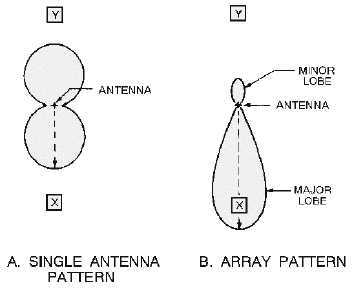4-29
radiates fairly efficiently in the desired direction toward receiving point X. It radiates equally as
efficiently toward Y, although no radiation is desired in this direction. The antenna in view B radiates
strongly to point X, but very little in the direction of point Y, which results in more satisfactory operation.
Figure 4-24.—Single antenna versus array.
Major and Minor Lobes
The pattern shown in figure 4-24, view B, has radiation concentrated in two lobes. The radiation
intensity in one lobe is considerably stronger than in the other. The lobe toward point X is called a
MAJOR LOBE; the other is a MINOR LOBE. Since the complex radiation patterns associated with
arrays frequently contain several lobes of varying intensity, you should learn to use appropriate
terminology. In general, major lobes are those in which the greatest amount of radiation occurs. Minor
lobes are those in which the radiation intensity is least.
Q26. What is the purpose of antenna stubs?
Q27. What is the primary difference between the major and minor lobes of a radiation pattern?
DIRECTIONAL ARRAYS
You have already learned about radiation patterns and directivity of radiation. These topics are
important to you because using an antenna with an improper radiation pattern or with the wrong
directivity will decrease the overall performance of the system. In the following paragraphs, we discuss in
more detail the various types of directional antenna arrays mentioned briefly in the "definition of terms"
paragraph above.
Collinear Array
The pattern radiated by the collinear array is similar to that produced by a single dipole. The addition
of the second radiator, however, tends to intensify the pattern. Compare the radiation pattern of the dipole
(view A of figure 4-25) and the two-element antenna in view B. You will see that each pattern consists of
two major lobes in opposite directions along the same axis, QQ1. There is little or no radiation along the

